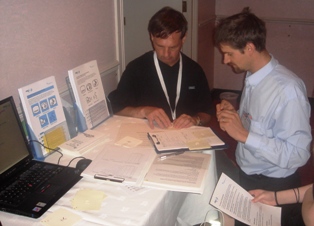Specialist Task Force 286:
Access symbols for use with video
content and ICT devices
Who we are:
Team Leader : Walter Mellors
Team Members : Richard Hodgkinson
Clive Miller
What we do :
The STF is funded by EC/EFTA to produce
an ETSI Standard on access symbols for use with video content and ICT devices.
We have now completed the testing of the
family of symbols suitable for a wide range of contexts. We would like to thank
all of you who assisted our work by taking part in the tests.
The draft of the standard containing the
chosen symbols was accepted to go for members' vote at the HF
meeting in June as
ES 202 432
The Technical Report
which describes the development and testing of the symbols was approved for
publication at the HF meeting in September
Tactile and auditory equivalents of the
symbols were tested at
Sight Village in Birmingham,
England. The photographs show a tactile test in progress and a general view of
part of the exhibition (Download
Mission Report).


The STF has had a number of liaison
meetings and made various presentations during the work. Some are listed below:
Read our
Terms
of Reference
Why we do it:
The work of the STF will address the
central philosophy of the eEurope action plan.
"The Lisbon strategy is not just
about productivity and growth but also about employment and social cohesion.
eEurope 2005 puts users at the centre. It will improve participation, open up
opportunities for everyone and enhance skills.” eEurope 2005".
To enable video media to be accessible
to sight impaired, deaf and hard of hearing people, the video content must be
supplemented with special access services. These services include subtitling,
where text is displayed to convey content that would otherwise only be audible;
signing, as a substitute for text for users whose native language is signing;
and audio description for sight impaired users who benefit from an audible
representation of the visual content. For sight impaired users of mobile
telephones, which conventionally rely heavily on visual interaction, the
provision of voice command and voice output facilities can enable access.
Access services are becoming
increasingly available, but a significant barrier to their use is lack of
consumer awareness. To inform users or their carers that such access services
are available, a common global set of language-independent symbols are required.
The work will contribute to the
implementation of the eEurope 2005 Action Plan in the area of e-inclusion
and promote a common approach by network providers and
equipment manufacturers in developing products and services that respond to the
specific needs of people with disabilities.
Through the involvement of stakeholders
the work will facilitate the revision of European and international standards
with the view to better respecting the specific needs of disabled users.
Time plan for the work:
We intend to complete our work in
November 2006 and publish the standard by February 2007.
How to contact us:
If you would like more information,
please contact the STF Leader:
mellors@etsi.org
Note: this information is based upon STF working assumptions.
The views expressed do not necessarily represent the position of ETSI in this
context.
Last updated: 2010-02-18 10:21:48